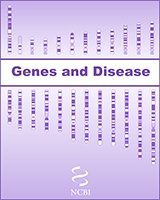NCBI Bookshelf. A service of the National Library of Medicine, National Institutes of Health.
National Center for Biotechnology Information (US). Genes and Disease [Internet]. Bethesda (MD): National Center for Biotechnology Information (US); 1998-.

The distinct and rather peculiar characteristics of paroxysmal nocturnal hemoglobinuria (PNH) have puzzled hematologists for more than a century. PNH is characterized by a decreased number of red blood cells (anemia), and the presence of blood in the urine (hemoglobinuria) and plasma (hemoglobinemia), which is evident after sleeping. PNH is associated with a high risk of major thrombotic events, most commonly thrombosis of large intra-abdominal veins. Most patients who die of their disease die of thrombosis.
PNH blood cells are deficient in an enzyme known as PIG-A, which is required for the biosynthesis of cellular anchors. Proteins that are partly on the outside of cells are often attached to the cell membrane by a glycosylphosphatidylinositol (GPI) anchor, and PIG-A is required for the synthesis of a key anchor component. If PIG-A is defective, surface proteins that protect the cell from destructive components in the blood (complement) are not anchored and therefore absent, so the blood cells are broken down.
The PIG-A gene is found on the X chromosome. Although not an inherited disease, PNH is a genetic disorder, known as an acquired genetic disorder. The affected blood cell clone passes the altered PIG-A to all its descendants—red cells, leukocytes (including lymphocytes), and platelets. The proportion of abnormal red blood cells in the blood determines the severity of the disease.
Related diseases
- Genome view see gene locations
- Entrez Gene collection of gene-related information
- BLink related sequences in different organisms
- Research articles online full text
- Books online books section
- OMIM catalog of human genes and disorders
- Paroxysmal nocturnal hemoglobinuria - Genes and DiseaseParoxysmal nocturnal hemoglobinuria - Genes and Disease
Your browsing activity is empty.
Activity recording is turned off.
See more...
